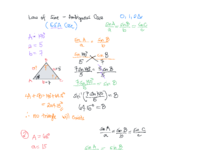Sine Law - Ambiguous Case (SSA)

Investigate the Ambiguity! [Part 1]
Using your knowledge of the law of sine, solve for the missing parts of the triangle. Show your triangle in your paper.
Remember that this is collaborative learning. Share all information with your groupmates.
Given: a = 5, b = 7, & ∠A = 140°
Question: Compute for ∠B.
Follow the solutions below:
Now, add the measurements of ∠A and ∠B. What's your answer? Does this make sense? Why or Why not?
What does this imply? Will you be able to form a triangle if this is the case? If so, how many? Summarize your answer as a group.
Investigate the Ambiguity! [Part 2]
Using your knowledge of the law of sine, solve for the missing parts of the triangle. Show your triangle in your paper.
Remember that this is collaborative learning. Share all information with your groupmates.
Given: a = 15, b = 12, & ∠A = 68°
Question: Compute for ∠B.
Follow the solutions below:
Now, add the measurements of ∠A and ∠B. What's your answer? Does this make sense? Why or Why not?
To know if there will be another triangle that can be formed using the same given, get the supplement of ∠B. That is, subtract your answer for ∠B to 180°. What's your answer?
Now, add the supplement of ∠B to the measure of ∠A. What did you get? Hint: 68° + supplement of ∠B =Answer
If the supplement of the computed angle is added to the original given angle and it sums up less than 180 degrees, then you have a second triangle. If this is not the case (sum is greater than 180 degrees), then only one triangle can be formed. QUESTION: Going back to your previous answer, will there be a second triangle that can be formed using the same given information?
In your own words, summarize your learnings for today by answering the questions below: 1. When will we know when no triangle will exist using the given information? 2. When will we know when exactly ONE triangle will exist using the given information? 3. When will we know when there could be TWO different triangles that will exist using the given information?
